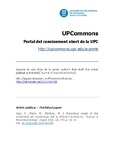Mostrar el registro sencillo del ítem
A theoretical model of the endothelial cell morphology due to different waveforms
| dc.creator | Sáez, Pablo | es_ES |
| dc.creator | Malvè, Mauro | es_ES |
| dc.creator | Martínez, Miguel Ángel | es_ES |
| dc.date.accessioned | 2020-09-16T11:21:46Z | |
| dc.date.available | 2020-09-16T11:21:46Z | |
| dc.date.issued | 2015 | |
| dc.identifier.issn | 0022-5193 | |
| dc.identifier.uri | https://hdl.handle.net/2454/38107 | |
| dc.description.abstract | Endothelial cells are key units in the regulatory biological process of blood vessels. They represent an interface to transmit variations on the fluid dynamic changes. They are able to adapt its cytoskeleton, by means of microtubules reorientation and F-actin reorganization, due to new mechanical environments. Moreover, they are responsible for initiating a huge cascade of biological processes, such as the release of endothelins (ET-1), in charge of the constriction of the vessel and growth factors such as TGF β and PDGF. Although a huge efforts have been made in the experimental characterization and description of these two issues the computational modeling has not gained such an attention. In this work we study the 3D remodeling of endothelial cells based on the main features of blood flow. In particular we study how different oscillatory shear index and the time average wall shear stresses modify the endothelial cell shape. We found our model fitted the experimental works presented before in in vitro studies. We also include our model within a computational fluid dynamics simulation of a carotid artery to evaluate endothelial cell shape index which is a key predictor of atheroma plaque formation. Moreover, our approach can be coupled with models of collagen and smooth muscle cell growth, where remodeling and the associated release of chemical substance are involved. | en |
| dc.description.sponsorship | Financial support for this research was provided by the Spanish Ministry of Science and Technology through research project DPI2013-44391-P, the Instituto de Salud Carlos III (ISCIII) through the CIBER initiative. CIBER-BBN is an initiative funded by the VI National R&D&i Plan 2008–2011, Iniciativa Ingenio 2010, Consolider Program, CIBER Actions and financed by the Instituto de Salud Carlos III with assistance from the European Regional Development Fund. | en |
| dc.format.extent | 10 p. | |
| dc.format.mimetype | application/pdf | en |
| dc.language.iso | eng | en |
| dc.publisher | Elsevier | en |
| dc.relation.ispartof | Journal of Theoretical Biology, 2015, 379, 16-23 | en |
| dc.rights | © 2015 Elsevier Ltd. This manuscript version is made available under the CC-BY-NC-ND 4.0. | en |
| dc.rights.uri | http://creativecommons.org/licenses/by-nc-nd/4.0/ | |
| dc.subject | Endothelial cells | en |
| dc.subject | Remodeling | en |
| dc.subject | CFD | en |
| dc.title | A theoretical model of the endothelial cell morphology due to different waveforms | en |
| dc.type | info:eu-repo/semantics/article | en |
| dc.type | Artículo / Artikulua | es |
| dc.contributor.department | Ingeniería Mecánica, Energética y de Materiales | es_ES |
| dc.contributor.department | Mekanika, Energetika eta Materialen Ingeniaritza | eu |
| dc.rights.accessRights | info:eu-repo/semantics/openAccess | en |
| dc.rights.accessRights | Acceso abierto / Sarbide irekia | es |
| dc.identifier.doi | 10.1016/j.jtbi.2015.04.038 | |
| dc.relation.projectID | info:eu-repo/grantAgreement/MINECO//DPI2013-44391-P/ES/ | en |
| dc.relation.publisherversion | https://doi.org/10.1016/j.jtbi.2015.04.038 | |
| dc.type.version | info:eu-repo/semantics/acceptedVersion | en |
| dc.type.version | Versión aceptada / Onetsi den bertsioa | es |



